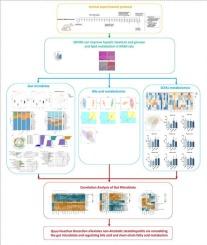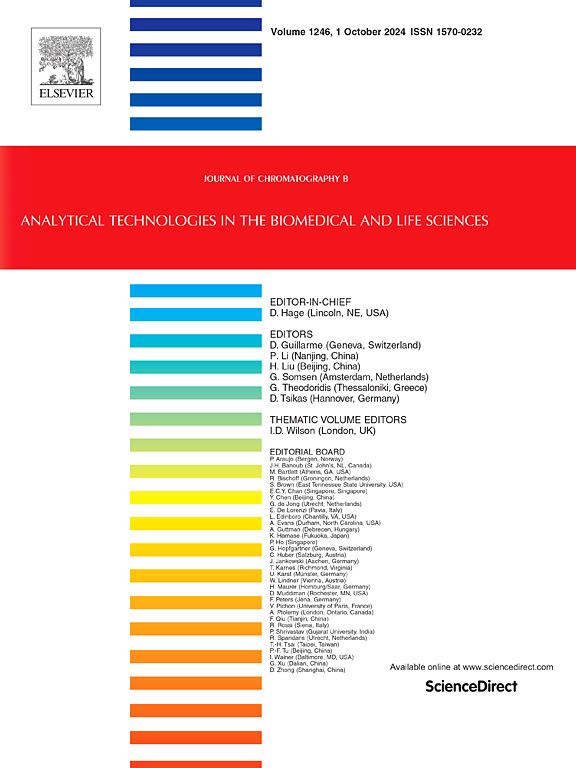Quyu Huazhuo Decoction alleviates non-Alcoholic steatohepatitis via remodeling the gut microbiota and regulating bile acid and short-chain fatty acid metabolism
IF 2.8
3区 医学
Q2 BIOCHEMICAL RESEARCH METHODS
引用次数: 0
Abstract
Non-alcoholic steatohepatitis (NASH), a globally prevalent metabolic disorder, exhibits a complex and incompletely understood pathogenesis with limited clinical treatment options available. Studies have shown that Quyu Huazhuo Decoction (QYHZD) can effectively reduce insulin resistance and improve liver function in NASH patients, though its underlying mechanisms remain unclear. Using a high-fat diet (HFD)-induced NASH rat model, the present study employed 16S rDNA sequencing along with targeted metabolomics of bile acids (BAs) and short-chain fatty acids (SCFAs) to systematically evaluate the therapeutic effects of QYHZD. The results showed that QYHZD significantly alleviated HFD-induced obesity, hepatic steatosis, inflammatory response, and glucose and lipid metabolism dysregulation. The intervention also reshaped the gut microbiota, promoting the growth of beneficial bacteria such as Akkermansia and Roseburia, while suppressing harmful taxa including Klebsiella and Desulfovibrio. Metabolomics analysis indicated that QYHZD intervention upregulated protective BAs (e.g., UDCA, CDCA, and their conjugated forms) and SCFAs (e.g., butyric acid and valeric acid), along with reduced production of toxic BAs such as DCA. In conclusion, this study revealed that QYHZD improves the progression of NASH through multi-axis regulation of “microbiota-BA/SCFA-metabolism”, providing experimental evidence and mechanistic insights for the use of traditional Chinese medicine in treating metabolic liver diseases.

祛瘀化浊汤通过重塑肠道菌群,调节胆汁酸和短链脂肪酸代谢来缓解非酒精性脂肪性肝炎
非酒精性脂肪性肝炎(NASH)是一种全球普遍存在的代谢性疾病,其发病机制复杂且尚不完全清楚,临床治疗方案有限。研究表明,祛瘀化浊汤(QYHZD)可有效降低NASH患者胰岛素抵抗,改善肝功能,但其作用机制尚不清楚。本研究采用高脂饮食(HFD)诱导的NASH大鼠模型,采用16S rDNA测序以及胆汁酸(BAs)和短链脂肪酸(SCFAs)的靶向代谢组学方法,系统评估QYHZD的治疗效果。结果显示,清热补益汤能显著缓解食油致肥胖、肝脂肪变性、炎症反应和糖脂代谢失调。干预还重塑了肠道微生物群,促进了有益细菌(如Akkermansia和Roseburia)的生长,同时抑制了包括克雷伯氏菌(Klebsiella)和脱硫弧菌(Desulfovibrio)在内的有害菌群。代谢组学分析表明,QYHZD干预上调了保护性BAs(如UDCA、CDCA及其共轭形式)和短链脂肪酸(如丁酸和戊酸),同时减少了毒性BAs(如DCA)的产生。综上所述,本研究揭示清血清汤通过多轴调控“微生物- ba / scfa -代谢”改善NASH的进展,为中药治疗代谢性肝病提供实验依据和机制见解。
本文章由计算机程序翻译,如有差异,请以英文原文为准。
求助全文
约1分钟内获得全文
求助全文
来源期刊

Journal of Chromatography B
医学-分析化学
CiteScore
5.60
自引率
3.30%
发文量
306
审稿时长
44 days
期刊介绍:
The Journal of Chromatography B publishes papers on developments in separation science relevant to biology and biomedical research including both fundamental advances and applications. Analytical techniques which may be considered include the various facets of chromatography, electrophoresis and related methods, affinity and immunoaffinity-based methodologies, hyphenated and other multi-dimensional techniques, and microanalytical approaches. The journal also considers articles reporting developments in sample preparation, detection techniques including mass spectrometry, and data handling and analysis.
Developments related to preparative separations for the isolation and purification of components of biological systems may be published, including chromatographic and electrophoretic methods, affinity separations, field flow fractionation and other preparative approaches.
Applications to the analysis of biological systems and samples will be considered when the analytical science contains a significant element of novelty, e.g. a new approach to the separation of a compound, novel combination of analytical techniques, or significantly improved analytical performance.
 求助内容:
求助内容: 应助结果提醒方式:
应助结果提醒方式:


